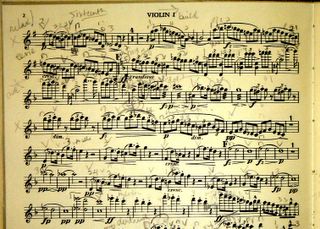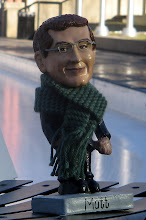1. Bring your A list - wipe out your Bs and Cs
A first step after you get a list is to divide it into three lists: the A list, containing pieces you know very well, have performed, feel confident about; B, pieces you have some familiarity with, need some work on; and the C list, pieces you barely know at all. Categorizing in this way can help prioritize your practice time, making a long list of excerpts seem more manageable. The idea is to concentrate most on the B and C lists, with the goal of quickly getting everything into your 'A' list. Ideally the last 30 days can be used to practice auditioning, having already learned all the notes, bowings, articulations, etc.
In order to get there, it is helpful to actually design a practice schedule; focus your most intense practice time on the excerpts that need the most work, and be very disciplined about following your schedule strictly, even setting an exact amount of warm-up time, for example. If you know you only have fifteen minutes to work on something, find a single phrase or concept that you can focus on and bring it to A material.
If you have any "maybe" excerpts, things you hope they won't ask, not only will it test your luck, it will undermine your confidence going into the audition - you want to have an attitude of "bring it", ready for anything they could ask.
2. If you don’t know the tempo, you're wasting a plane ticket
One of the things TF was most adamant about was the need to develop tempo awareness and memory, just like pitch awareness. Playing an excerpt too slow will work against you - they'll think you're unexperienced, overly careful, boring - and playing too fast will be even more harmful. No one wants to sit next to the person who rushes like crazy in difficult passages, and committees hate asking people to "play it again, slower".
The solution TF offered was to be extremely fastidious about checking tempos, finding several different recordings and using a metronome with tap function to accurately measure the tempos in every section, then marking those tempos clearly in your parts. That way, you won't be practicing a vague idea of what the tempo might be, you'll be working from a tempo that a reputable orchestra actually used. Knowing precise tempos can also help evaluate recordings of your own playing, since you can set a metronome and see where you stray from the pulse.
In order to demonstrate that tempo memorization is an achievable goal, TF asked us to give him a metronome marking, just off the top of our heads. 131, someone said - he made little percussionist motions, imagining some piece - then tapped a Dr. Beat four times and turned it to face the class - it said 131. Someone else said 73, and the same thing happened, he hit it exactly. In the second class, he was given 42 and 147, and he wasn't quite as accurate - still, he was only off by 1 on each.
Another suggestion was to play along with recordings, and study the scores so you can really hear the rest of the orchestra when you play. A great tool is an iPod or other MP3 device, which can store clips from several different recordings for easy reference and study. TF told us he has at least five different recordings of each New York Phil audition piece on his iPod.
3. Organize the parts, erase the panic
Another often overlooked step is to organize and clean your parts. Every list is different, but in most cases it is a good idea to have two notebooks, one with the full parts and another with just the excerpts you know they will call. Most of your work will be on the short list book, but the full part book will help you to gain a familiarity with the whole piece, and be ready should they ask you to sight-read a non-standard excerpt.
After compiling your books, you might need to do some more secretarial work - in addition to marking accurate tempi, get rid of all the cluttered, gratuitous markings you or others may have added to the part. We've all seen these markings - don't rush, vibrate, the little tuning arrows, the cryptic scribbles... Last week I saw a horn part on which every phrase was labeled with some kind of dairy product: skim, heavy cream, buttermilk, etc. - apparently this is some kind of breathing system. If it isn't your bowing, phrasing, articulation, or beverage visualization tool, though, it's just a recipe for panic and distraction - erase it!

meticulous annotation, or fear writ illegibly?

The next installment contains more of Tom Freer's advice on audition preparation. Click here to read part I of audition habits of a highly effective percussionist. And many thanks to Tom Freer for the advice and editorial help!


 Technorati Link Count: no. of blog reactions to this post
Technorati Link Count: no. of blog reactions to this post
2 comments:
Thanks Matt for the organized and summarized post on TF's discussion. I won't need to clean up my notes now!
davis - Happy to be of help! It's always nice to attract people besides bored family members and confused Germans to hella frisch. Not that I don't appreciate those visitors as well. They rarely get as excited about tap function metronomes as I do, though.
If you notice anything missing or needing further explanation, please let me know!
Post a Comment